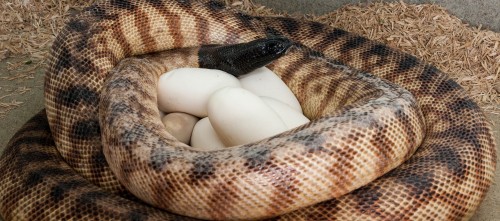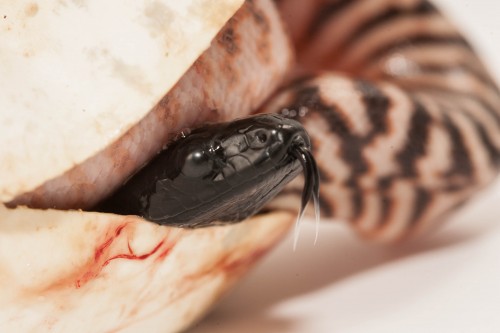 Blackhead Pythons are probably one of the easiest pythons a keeper could have. They reach impressive sizes, are eager feeders, and are very forgiving of keeper errors. Because of their expansive and climatically varied natural range, they are highly adaptable to nearly any captive condition. This makes them generally without shedding problems and equipped to handle a wide range of temperatures. It stands to reason that a species at home in so many natural habitats should feel quite comfortable within the narrow range of extremes they will face in the captive environment.
Blackhead Pythons are probably one of the easiest pythons a keeper could have. They reach impressive sizes, are eager feeders, and are very forgiving of keeper errors. Because of their expansive and climatically varied natural range, they are highly adaptable to nearly any captive condition. This makes them generally without shedding problems and equipped to handle a wide range of temperatures. It stands to reason that a species at home in so many natural habitats should feel quite comfortable within the narrow range of extremes they will face in the captive environment.
The temperament of captive Blackheads is as variable as the snake itself, but generally very pleasant. Babies will often bluff by flattening their heads with an open-mouthed hiss. When striking, it is very rare in our experience that a Blackhead will truly bite. They lunge aggressively forward with a closed mouth in a “head-butt” attempt to scare the source of agitation. Adults are very inoffensive, rarely offering even a hint of discontentment while being handled. Larger adults make quite fantastic displays with their long, mature hood and muscular build.
Blackheads are very easily housed in captivity. Babies can be started in the commonly seen tub rack systems. All they need is a thermal gradient (80 cool-end/ 90 warm-end), a suitable substrate, and a water bowl and they will thrive. As they grow, our juveniles are progressively stepped through larger and larger tubs until 4 to 5 feet long. At this point, they can be moved into their permanent enclosures. An enclosure with 4 feet by 2 feet of floor space is suitable for adult males. The larger females will benefit from a roomy 6 feet by 2 or 2 ½ feet of floor area. Adults should also be given a wider thermal gradient than offered to juveniles. A basking spot of up to 95 degrees and a cool end temperature down to 80 degrees is ideal. Adult Blackheads greatly appreciate top entry hide boxes, giving the sense of a subterranean burrow.
 There are many acceptable substrates for these adaptable pythons. Avoid things like pine and cedar shavings due to the oils they contain. Newsprint works great for raising babies. Aspen, CareFresh, and paper (newsprint or cage liners) can be used for adults. Substrates that have small debris mixed in such as cypress mulch aren’t recommended for Aspidites.
There are many acceptable substrates for these adaptable pythons. Avoid things like pine and cedar shavings due to the oils they contain. Newsprint works great for raising babies. Aspen, CareFresh, and paper (newsprint or cage liners) can be used for adults. Substrates that have small debris mixed in such as cypress mulch aren’t recommended for Aspidites.
Feeding Blackheads is one of the great joys of ownership for keepers. They process their food quickly and efficiently and grow at a tremendous rate. Young Blackheads can easily be raised to adult size in 2 ½ to 3 years. It is hard to overfeed growing Blackheads but mature specimens must be prevented from becoming obese. This can be accomplished by offering multiple smaller rats as opposed to feeding single large meals. A good feeding schedule for juveniles is a meal every 5 to 7 days. Adults should be fed medium rats every 2 to 3 weeks for maintenance with pre-breeding females being fed every 10 days. There are no problems or dietary “quirks” with this species; they rarely refuse a meal and are always looking forward to their next dining experience.
Not only do Blackheads make easy captives they are incredibly interesting as well. Although there is no way to accurately evaluate the intelligence of a snake, Blackheads seem quite astute and interested in their surroundings. They are well aware of their domain and seem very curious about the outside world. Blackheads can often be seen sitting for extended periods with their hooded neck and head at a constant 40 to 90-degree angle while their bodies are well hidden beneath the substrate. They do this, particularly when outside, much like our North American Racers (Coluber constrictor) can be seen doing in the field.